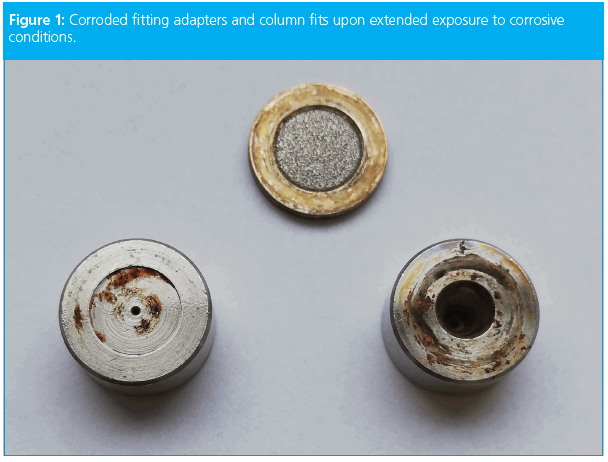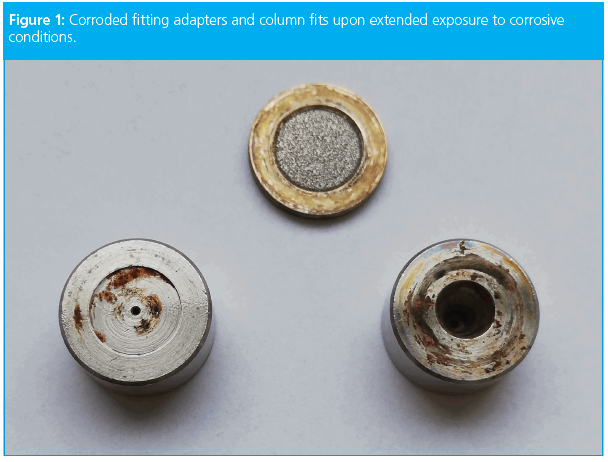Tips & Tricks: Treating Your GPC/SEC System Properly
Gel permeation chromatography/size-exclusion chromatography (GPC/SEC) systems are high performance chromatographic instruments. They are produced to be run 24/7 and to yield stable and reliable results. However, the reliability of the analytical results depends upon proper usage of both instrument and columns. This instalment of Tips & Tricks will provide some helpful pointers to keep your system in good shape.
Gel permeation chromatography/size‑exclusion chromatography (GPC/SEC) has become the workhorse for the separation of macromolecules. GPC/SEC is a liquid chromatographic separation technique; typical applications use organic solvents and/or aqueous solvents at high salt load and/or high or low pH. Such conditions may pose challenges to instrumentation and columns. Improper handling may result in irreproducible results, frequent repairs, reduced lifetime, and regular downtime.
Selecting GPC/SEC Systems
The first step in preventing unnecessary repairs and downtime of a GPC/SEC system is by selecting a suitable instrument. While at first glance a GPC/SEC system is a standard high performance liquid chromatography (HPLC) instrument, one should keep in mind that the majority of typical HPLC applications feature low molar mass molecules, which are often run on reversed-phase columns. Such applications usually apply mixtures of water and acetonitrile or methanol as mobile phases. Since these are the major applications, instrument manufacturers often focus on this market and design instrumentation accordingly. Due to the incompatibility of certain instrument components (seals, tubing) with the eluents applied in typical GPC/SEC applications, these system components may need to be exchanged to avoid complications. These instrument modifications might not be directly visible but are essential to provide good long-term performance. A typical example is the use of hexafluoro isopropanol (HFIP) as eluent to run polyamides or polyesters. This solvent is known to destroy certain membranes used in some manufacturers degassers. Also, dimethylacetamide (DMAc) or dimethylformamide (DMF), which are often applied in GPC/SEC using lithium bromide (LiBr) or lithium chloride (LiCl) as the additive, are highly corrosive. The same holds true when using chloroform. Thus, if unsuitable capillaries or frits are applied problems can be foreseen. The use of columns with appropriate frits (for example, Ag/Ti or PEEK/ Ti) reduces the risk of column corrosion (see Figure 1). Even tetrahydrofuran (THF), which is frequently applied in GPC/SEC, is sometimes not compatible with certain standard HPLC equipment. Depending upon the manufacturer, the instrument may be directly modified by the vendor to be applicable for GPC/SEC eluents, or compatibility kits may be available. In any case, it makes sense to have the manufacturer assure compatibility for the anticipated solvents before buying the instrument.

Changing Solvent in GPC/SEC Systems
While some companies use a differentvinstrument for each eluent, samplevthroughput could be too low for othersvto follow this approach. Therefore, switching from one eluent to another on the same instrument is often required.
While nearly all instrument manufacturers recommend switching only between miscible solvents—which sometimes requires application of an intermediate solvent miscible with both solvents—the effect of salts used as additives in certain GPC/SEC eluents is frequently overlooked. While the solvents may be compatible with each other, the solubility of the additives may not be given in the solvents that need to be exchanged. Thus, when switching from a salt-containing eluent to a different solvent, the salts may precipitate, resulting in blocked capillaries or columns. It is therefore advisable to first flush out the salt completely using the pure solvent applied last, before switching to the new solvent and further on to the salt-containing new eluent.
Keep in mind that certain parts of the instrument are not permanently flushed with eluent. Care must be taken to also flush those lines that are not permanently in flow. In injection valves, either bypass or mainpass will be flown through by the solvent. Reference cells, for example, of refractive index (RI) detectors, or recycle and/or waste capillaries and tubing may also not be in permanent flow.
Therefore, when flushing out salts of the preceding eluent, the respective valves should be switched a couple of times to ensure that all lines present have been flushed.
Incomplete flushing of capillary bridges in viscosity detectors as well as hold-back columns or hold-back reservoirs are also a frequent source of trouble. High back pressure due to immiscible solvents as well as blocked viscometer capillaries by precipitation of salts can damage pressure transducers, thereby resulting in expensive repairs.
Changing Solvent in GPC/SEC Columns
Similar caution should be taken with the columns when switching eluents. Here, in addition to compatibility between solvent, the compatibility between solvent and stationary phase needs to be considered. Introduction of even less than a millilitre of an incompatible eluent onto the stationary phase may irreversibly damage the column.
Organic packings—often applied in GPC/SEC applications—may swell differently in different solvents. Since swelling/deswelling processes require time, solvent exchanges should be done at a reduced flow rate. It is highly recommended to check the column manual for solvent compatibility and proposed flow rates.
Shutting Down SEC/GPC Systems
Before a weekend/vacation, or when sample throughput is low, the user often asks themselves whether it makes sense to shutdown a GPC/SEC system to reduce wear and save solvent and energy. But how much time is lost by restarting and equilibrating the system and columns?
There is no general answer to this; it depends on the length of the shutdown compared to the time for equilibration and the time frame within which new samples have to be analyzed.
In most cases shutting down the complete instrument over the weekend is not helpful, provided safety features such as leak sensors are activated and a suitable value for minimum and maximum pump pressure is set. Setting a lower pressure limit prevents pumping air onto the column if the solvent reservoir becomes empty. Setting a high pressure limit prevents column damage by unexpected capillary blockings or applying a too high flow rate.
Only those instrument components that are quickly ready for operation (for example, the autosampler, UV detector, evaporative light scattering detector [ELSD]) should be switched off. Components that require very stable temperatures due to their sensitivity to temperature variations (RI or viscosity detectors) should not be shut off because of the sometimes quite long times required to establish stable baselines.
Depending on the eluent applied, different strategies can be applied to save solvents. If pure, non-corroding solvents (THF, toluene) are used, the pump can be switched off or the system can be run in recycle mode. Modern instruments are equipped with recycle valves, which at the end of the analysis direct the solvent flow to the solvent reservoir. For older systems, the waste tubing of the detector can be placed manually into the solvent reservoir at the end of the run. As no solvent is wasted, the standard flow rate can be kept.
When using potentially corrosive eluents such as water with salt, or halogenated solvents such as chloroform, DMAc, or DMF with salt, it is not recommended to redirect the effluent to the reservoir but directly to waste. This is because the impurities from corrosion are reintroduced via the reservoir into the system and onto the columns, affecting instrument and column performance.
While aqueous solvents can be directed to waste at standard flow rate, the flow rate of organic solvents could be reduced to 0.1 mL/min, minimizing solvent consumption and preventing unnecessary prolonged exposure of solvent and column. When returning to analytical operation, the column should be allowed to properly equilibrate at the new flow rate because different swelling states of the column material at low and high pressure may affect analytical results.
If the instrument is not used for a long time (more than a week), the system should be shut off completely. The instrument and columns should be filled with non-corroding (salt-free) solvent. Any eluent in the columns that contains salt or acids should be replaced before column storage. For columns applied in aqueous applications, storage in water/NaN3 (200 mg/L) or water containing some methanol are suited to prevent microbial growth. When removing the columns from the system, use end plugs to prevent the column(s) drying out. Store columns in a cool place to avoid possible solvent evaporation, but never allow the eluent in the column to freeze, as this may destroy the column bed.
Summary
- GPC/SEC solvents pose a challenge to HPLC equipment. Care should therefore be taken with solvent compatibility for the anticipated application when purchasing the instrument.
- When changing eluent in GPC/SEC systems, use miscible solvents, consider the solubility of salts in the new eluent, and flush all lines of the instrument, keeping in mind those lines that are not in flow all the time.
- Short-term shutdown of GPC/SEC instrumentation is not recommended.
- To reduce solvent consumption, apply recycle mode only for non-corroding eluents.
- When using corrosive eluents, do not recycle eluent to reduce solvent consumption. Reduce flow when no analysis is undertaken and direct eluent directly to waste. Provide sufficient time for column equilibration when returning to original flow rate.
- In the case of long-term shutdowns, completely replace corrosive and salt-containing eluents from the system and columns.
Wolfgang Radke studied polymer chemistry in Mainz, Germany, and Amherst, Massachusetts, USA, and is head of the application development department at PSS—now a part of Agilent. He is also responsible for instrument evaluation and for customized trainings.

Troubleshooting Everywhere! An Assortment of Topics from Pittcon 2025
April 5th 2025In this installment of “LC Troubleshooting,” Dwight Stoll touches on highlights from Pittcon 2025 talks, as well as troubleshooting advice distilled from a lifetime of work in separation science by LCGC Award winner Christopher Pohl.
Characterizing Plant Polysaccharides Using Size-Exclusion Chromatography
April 4th 2025With green chemistry becoming more standardized, Leena Pitkänen of Aalto University analyzed how useful size-exclusion chromatography (SEC) and asymmetric flow field-flow fractionation (AF4) could be in characterizing plant polysaccharides.
Rethinking Chromatography Workflows with AI and Machine Learning
April 1st 2025Interest in applying artificial intelligence (AI) and machine learning (ML) to chromatography is greater than ever. In this article, we discuss data-related barriers to accomplishing this goal and how rethinking chromatography data systems can overcome them.
Study Examines Impact of Zwitterionic Liquid Structures on Volatile Carboxylic Acid Separation in GC
March 28th 2025Iowa State University researchers evaluated imidazolium-based ZILs with sulfonate and triflimide anions to understand the influence of ZILs’ chemical structures on polar analyte separation.













